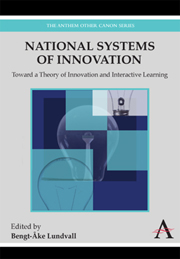Book contents
- Frontmatter
- Contents
- List of Tables
- List of Figures
- Preface
- 1 Introduction
- Part I Toward a New Approach to National Systems of Innovation
- Part II A Closer Look at National Systems of Innovation
- 5 Work Organisation and the Innovation Design Dilemma
- 6 Innovation and the Development of Industrial Networks
- 7 The Public Sector as a Pacer in National Systems of Innovation
- 8 The Role of Finance in National Systems of Innovation
- 9 Formal Scientific and Technical Institutions in the National System of Innovation
- Part III Opening National Systems of Innovation: Specialisation, Multinational Corporations and Integration
- Notes
- References
6 - Innovation and the Development of Industrial Networks
from Part II - A Closer Look at National Systems of Innovation
Published online by Cambridge University Press: 05 March 2012
- Frontmatter
- Contents
- List of Tables
- List of Figures
- Preface
- 1 Introduction
- Part I Toward a New Approach to National Systems of Innovation
- Part II A Closer Look at National Systems of Innovation
- 5 Work Organisation and the Innovation Design Dilemma
- 6 Innovation and the Development of Industrial Networks
- 7 The Public Sector as a Pacer in National Systems of Innovation
- 8 The Role of Finance in National Systems of Innovation
- 9 Formal Scientific and Technical Institutions in the National System of Innovation
- Part III Opening National Systems of Innovation: Specialisation, Multinational Corporations and Integration
- Notes
- References
Summary
Introduction
In part I of this volume, it was argued that interactive learning in national systems of innovation (NSI) is strongly affected by the specific institutional set-up (chapter 2) and the specialisation in production structure (chapter 4). In chapter 3, the notion of user-producer interaction was introduced as a critical parameter for innovative success thus forming a micro-foundation for innovative industrial complexes and an important determinant for the performance of NSI's. The interaction between firms in user-producer relationships is not the only important type of interactive learning in innovative processes. In chapter 5 the interaction between various departments and functions within the firm were discussed.
Introducing now the notion of ‘industrial networks’, we set out to specify further, conceptually, the relationships between NSI's and industrial complexes/development blocks on the one hand and user-producer relationships on the other. The application of the network concept can serve as a qualitative as well as a quantitative specification of the micro-structure and micro-behaviour in NSI's.
However, the national level of systems of innovations will not be explicitly analysed in the present chapter. Its focus is on conceptual problems and on empirical illustrations mainly from Danish and Swedish industry. In this context, it should be mentioned that the concept of industrial networks also applies to international relationships (Imai and Baba, 1991). International industrial networks and inter-firm alliances will be discussed in chapter 13.
- Type
- Chapter
- Information
- National Systems of InnovationToward a Theory of Innovation and Interactive Learning, pp. 119 - 132Publisher: Anthem PressPrint publication year: 2010
- 2
- Cited by



